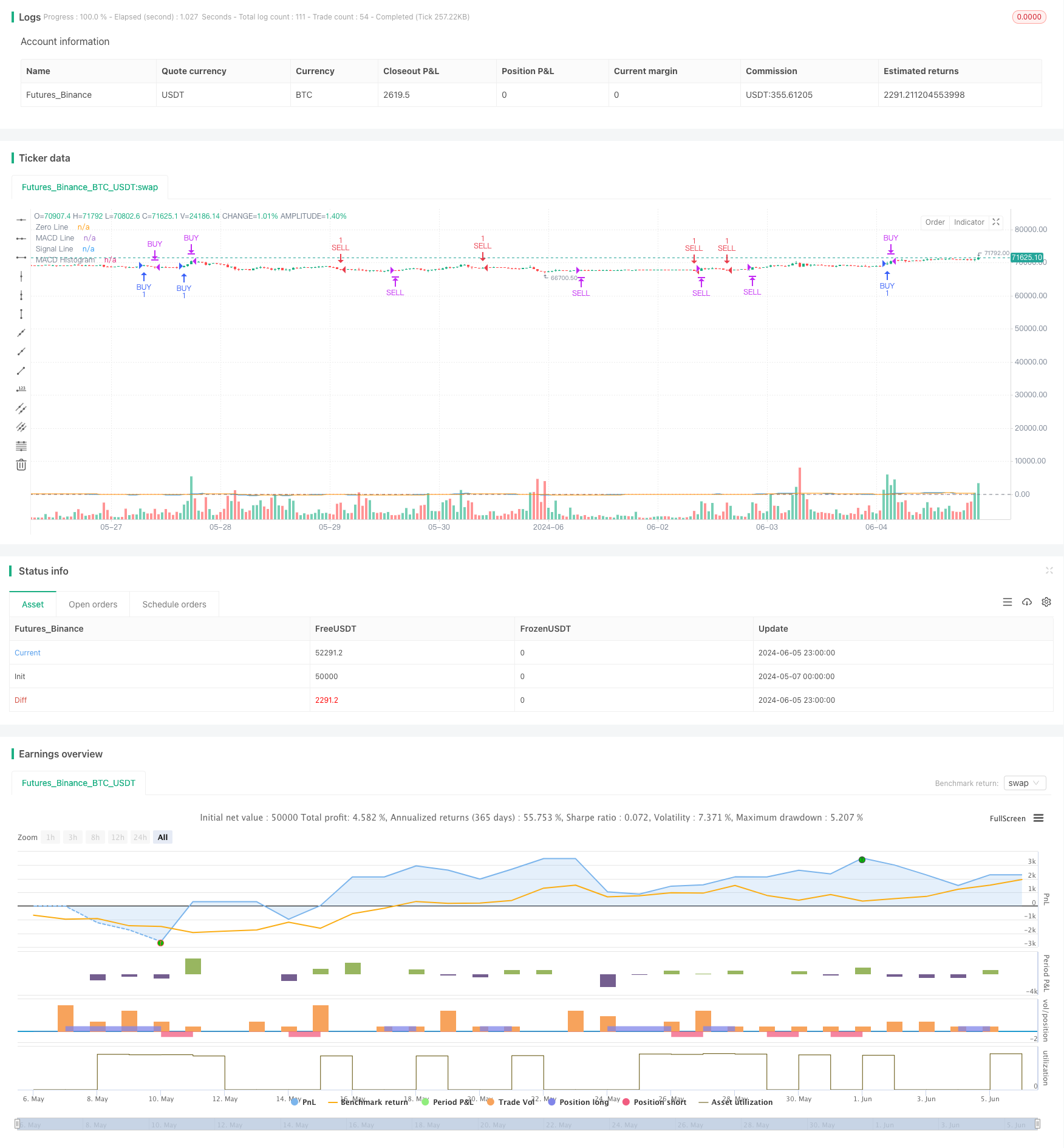
概述
该策略结合了MACD(移动平均线收敛背离指标)、RSI(相对强弱指数)和SMA(简单移动平均线)来生成可靠的买卖信号。MACD用于捕捉价格的动量变化,RSI用于识别超买和超卖状态,而SMA用于确认趋势方向。该策略通过多重条件过滤,以减少虚假信号,为日内交易提供明确的进出场点。
策略原理
- MACD:当MACD线从下向上穿过信号线时,产生做多信号;当MACD线从上向下穿过信号线时,产生做空信号。
- RSI:当RSI低于超买水平(70)时,才考虑做多;当RSI高于超卖水平(30)时,才考虑做空。这有助于避免在已经超买或超卖的情况下进场。
- SMA:50周期SMA和200周期SMA用于确认趋势方向。只有当50周期SMA在200周期SMA上方时,才考虑做多;只有当50周期SMA在200周期SMA下方时,才考虑做空。
该策略的进场和出场条件如下:
- 做多:当MACD线向上穿过信号线,RSI低于超买水平(70),且50周期SMA在200周期SMA上方(表明上升趋势)时,进场做多。
- 平多:当MACD线向下穿过信号线或RSI超过超买水平(70)时,平仓。
- 做空:当MACD线向下穿过信号线,RSI高于超卖水平(30),且50周期SMA在200周期SMA下方(表明下降趋势)时,进场做空。
- 平空:当MACD线向上穿过信号线或RSI跌破超卖水平(30)时,平仓。
策略优势
- 多重过滤机制可以有效减少虚假信号,提高信号可靠性。
- 结合动量指标和趋势确认指标,可以在趋势方向上寻找高概率交易机会。
- 明确的进出场规则,易于实现自动化交易,可以消除交易中的情绪因素。
- 适用于日内交易,可以快速适应市场变化,把握短期交易机会。
策略风险
- 在震荡市中,该策略可能会产生较多的虚假信号,导致频繁交易和资金损失。
- 策略依赖于历史数据优化参数,在市场状态发生重大变化时,可能需要重新优化参数。
- 突发的重大利好或利空消息可能导致价格突破超买或超卖水平,而该策略可能错过这些交易机会。
- 该策略没有设置止损,在极端行情下可能面临较大风险。
策略优化方向
- 引入更多的过滤条件,如交易量、波动率等,以进一步提高信号可靠性。
- 对不同的市场状态(如趋势、震荡)使用不同的参数组合,提高策略的适应性。
- 设置合理的止损和止盈水平,以控制单笔交易的风险和收益。
- 对策略进行回测和实盘测试,不断优化和调整参数,提高策略的稳健性。
总结
该策略通过结合MACD、RSI和SMA等技术指标,形成了一个多重过滤的日内交易策略。它利用动量和趋势的变化来捕捉交易机会,同时通过明确的进出场规则来控制风险。尽管该策略可能在震荡市中面临挑战,但通过进一步优化和风险管理,它有望成为一个可靠的日内交易工具。
策略源码
/*backtest
start: 2024-05-07 00:00:00
end: 2024-06-06 00:00:00
period: 1h
basePeriod: 15m
exchanges: [{"eid":"Futures_Binance","currency":"BTC_USDT"}]
*/
//@version=5
strategy("Day Trading Strategy", overlay=true)
// Parametrii pentru MACD
macdLength = input.int(12, title="MACD Length")
signalSmoothing = input.int(9, title="MACD Signal Smoothing")
src = input(close, title="Source")
// Calculul MACD
[macdLine, signalLine, _] = ta.macd(src, macdLength, 26, signalSmoothing)
macdHist = macdLine - signalLine
// Parametrii pentru RSI
rsiLength = input.int(14, title="RSI Length")
rsiOverbought = input.int(70, title="RSI Overbought Level")
rsiOversold = input.int(30, title="RSI Oversold Level")
// Calculul RSI
rsi = ta.rsi(src, rsiLength)
// Filtru suplimentar pentru a reduce semnalele false
longFilter = ta.sma(close, 50) > ta.sma(close, 200)
shortFilter = ta.sma(close, 50) < ta.sma(close, 200)
// Conditii de intrare in pozitie long
enterLong = ta.crossover(macdLine, signalLine) and rsi < rsiOverbought and longFilter
// Conditii de iesire din pozitie long
exitLong = ta.crossunder(macdLine, signalLine) or rsi > rsiOverbought
// Conditii de intrare in pozitie short
enterShort = ta.crossunder(macdLine, signalLine) and rsi > rsiOversold and shortFilter
// Conditii de iesire din pozitie short
exitShort = ta.crossover(macdLine, signalLine) or rsi < rsiOversold
// Adaugarea strategiei pentru Strategy Tester
if (enterLong)
strategy.entry("BUY", strategy.long)
if (exitLong)
strategy.close("BUY")
if (enterShort)
strategy.entry("SELL", strategy.short)
if (exitShort)
strategy.close("SELL")
// Plotarea MACD si Signal Line
plot(macdLine, color=color.blue, title="MACD Line")
plot(signalLine, color=color.orange, title="Signal Line")
hline(0, "Zero Line", color=color.gray)
plot(macdHist, color=color.red, style=plot.style_histogram, title="MACD Histogram")
相关推荐